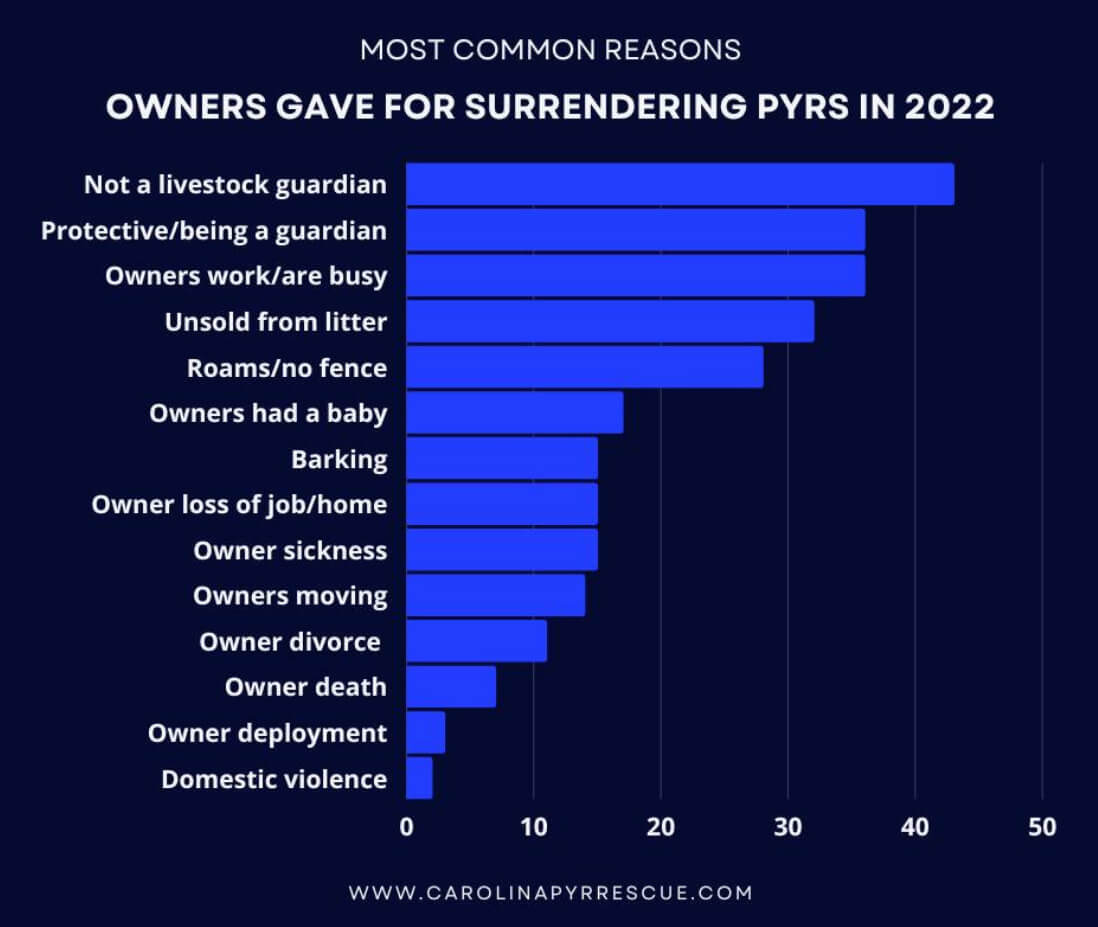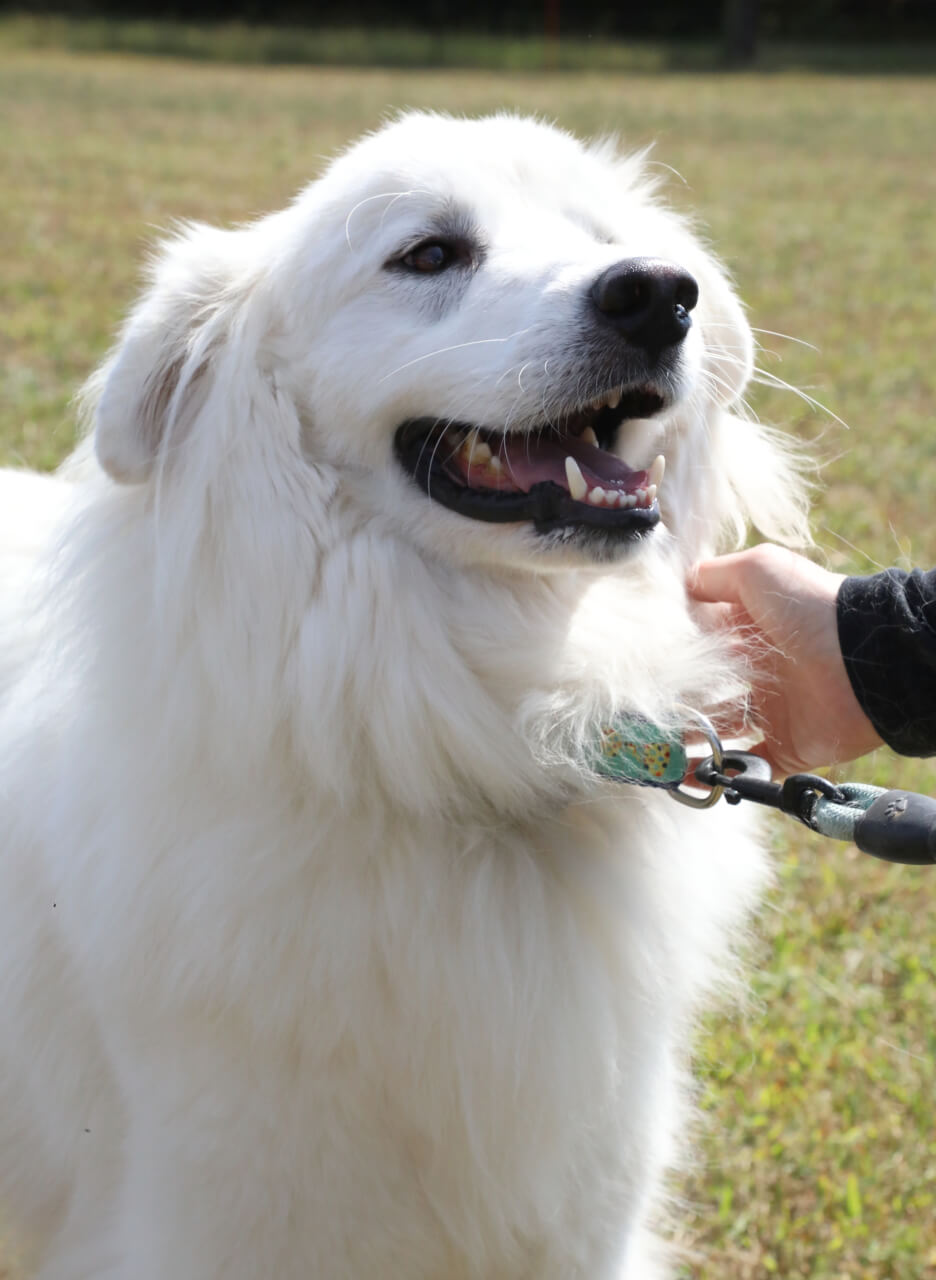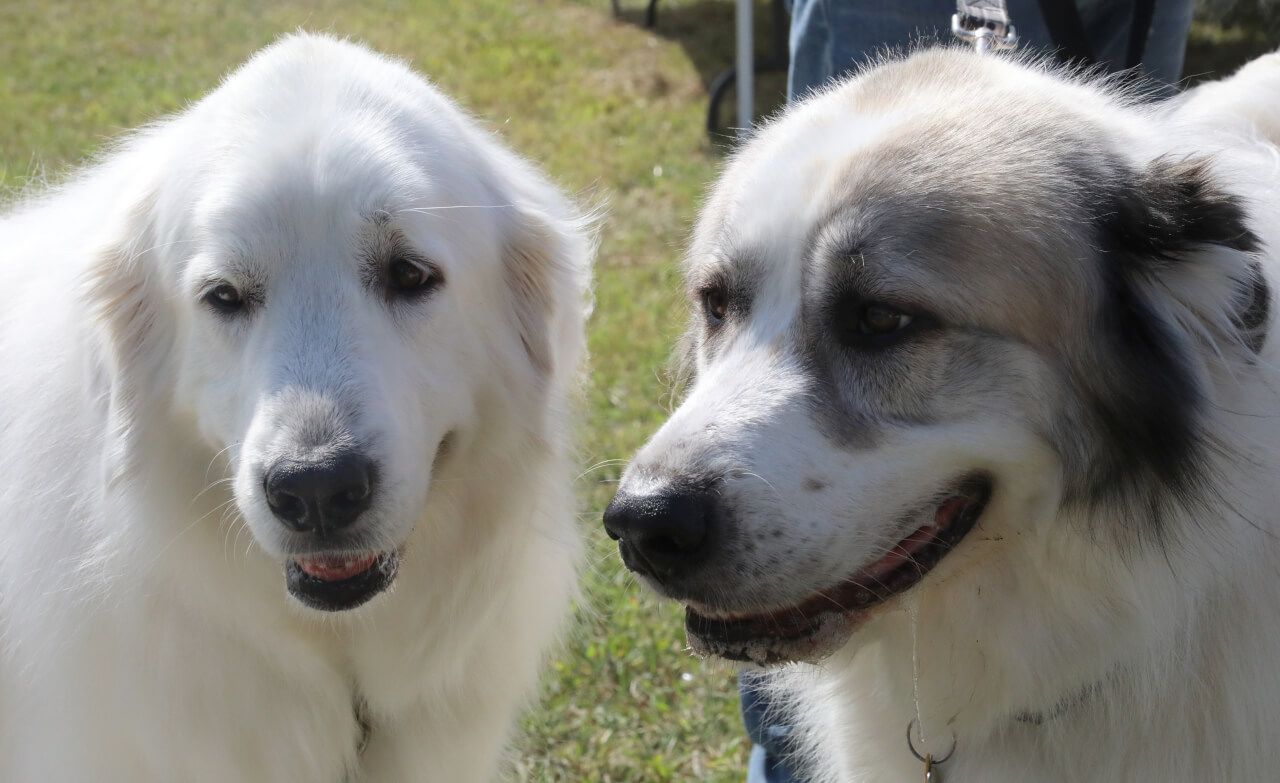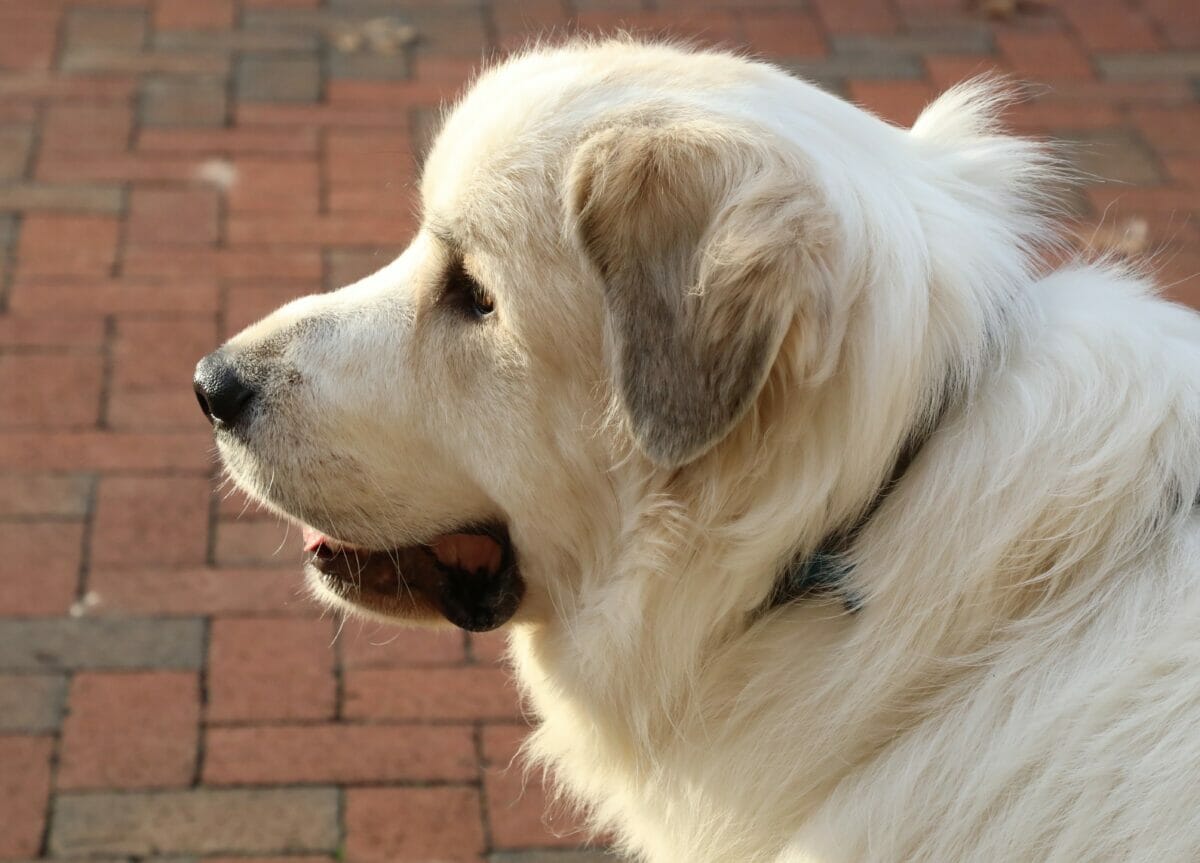These Dogs are in Crisis. Who Looks After the Guardians?
Livestock guardian dogs can do important work on farms. But they are being surrendered and euthanized in epic numbers.
On the last Tuesday of August, a vehicle pulled into Providence Farm in McLeansville, North Carolina. Joy Combs had been expecting these guests—they were from the Carolina Great Pyrenees Rescue (CGPR), and they were there to drop off a five-year-old Anatolian Shepherd named Max. Combs planned to work with the rescue to evaluate his behavior with farm animals and help place him in an appropriate home.
Max had lived on a farm as a working dog before being surrendered by his owner to a shelter in South Carolina.
“The story that we had about Max is the story that we get about so many dogs,” says Rose Stremlau, vice president of CGPR. The reason given for Max’s surrender was that he wasn’t working out as a livestock guardian.

Livestock Guardian Dogs (LGDs) are inherently smart, independent and very big. Traditionally, they’re working dogs that protect livestock from predators. This type of dog encompasses several breeds, Great Pyrenees (colloquially called “pyrs”) and Anatolians like Max being two common ones. They are bred to be good workers, but they also require training to do the job well. These dogs are also often adopted as non-working family pets.
A big dog with a happy face, Max had gotten skinny from the stress of the shelter environment. Because of factors including excessive breeding and improper handling, dogs like him are being surrendered and euthanized at crisis-level rates across the country. Rescues, including CGPR, are doing everything they can, but, according to Stremlau, it is not enough.
“It’s like trying to push the ocean back with a broom,” she says. “Impossible.”
Trending dogs
CGPR was founded in 1992. In the early days, Stremlau says, it was able to take and rehome all of the pyrs it was contacted about, about 100-150 per year. In the first eight months of 2023 alone, CGPR has been contacted about more than 630 dogs. It does not have the resources to keep up.
Stremlau attributes the surge in owner and breeder surrenders to the emergence of the modern homesteading trend, saying that as more people began keeping backyard chickens or goats, many decided to get an LGD to protect their new livestock.
To be successful guardians for livestock, these dogs need guidance. Without being properly trained and bonded to their livestock, the dogs won’t automatically protect them. Instead of guarding your chickens, says Stremlau, an untrained dog may treat your chickens like a squeaky toy. And in the end, this results in people surrendering their dogs when they can’t figure out how to manage them. Snapping at, biting or killing farm animals is not a sign of a failed guardian dog but a sign that someone failed to train it.
“Those are all behaviors that are normal in puppies and juvenile guardian dogs that owners who know what they’re doing, [or] social, confident adult guardian dogs would correct if the dog was properly socialized,” says Stremlau. COVID-19 paired with a lack of animal welfare laws exacerbated the situation, along with irresponsible breeding by breeders trying to cater to the trend. CGPR used to mostly field queries about adult dogs, but now it’s not uncommon to see surrenders of partial litters of puppies. Stremlau says approximately a third of the dogs CGPR receives come from farms, and the others come from urban or suburban areas where the dogs were either adopted as family pets or to guard a small number of backyard chickens.

Official organizations such as CGPR have trusted contacts, such as Combs of Providence Farm, that it calls for help. Combs has five working dogs, and she’s been able to help take in three dogs so far this year. That’s a lot for a volunteer, but it pales in comparison to the number of dogs she gets contacted about.
One Sunday this summer, Combs was contacted about 10 different Great Pyrenees needing placement: three pairs of adolescents, a pair of older pyrs and a pair of puppies. Through the network of contacts, placements were found for the puppies and the older dogs. The six adolescent dogs were euthanized. There was just nowhere to put them.
In terms of making a dent against these numbers, Combs says it feels like sticking your hand into a bucket of water.
“Once you pull your hand out,” she says, “there’s no evidence you were even there.”
Too many to help
Jean Harrison is the founder of the Big Fluffy Dog Rescue in Tennessee. She doesn’t agree that the number of dogs needing rescue is increasing. She says that the issue was always this bad, but, thanks to social media, people have a growing awareness of rescues, so the rescue groups get called upon more often for help with dogs who need placement. Regardless of why it’s happening, Harrison says the uptick in surrendered dogs is overwhelming and there are not nearly enough resources or rescues to help them all.
“Every day, I get up and I live a sort of existential hell,” says Harrison. “Before my feet have hit the floor as I get out of bed, I know that I’m going to get 3,000-4,000 emails every single day asking for help with a dog.”
To illustrate the point, Harrison toggles over to her email inbox. “I have 26,312 unread emails right now,” she says. “And I will never get to all of them.”

Sue Innamorato is the director of intake for National Great Pyrenees Rescue and verifies the trend across states, saying the numbers are overwhelming and depressing.
Innamorato believes the uptick is due to the combination of multiple factors. She’s observed that the majority of owner surrenders the rescue receives are from farms, but it’s also not uncommon to see litters of puppies who need homes. In some of the states where the problem is the most critical, such as Alabama, California, Texas and Tennessee, she says shelters can see 15-30 Pyrenees per month.
The best things people can do, she says, are to spay and neuter their dogs, provide working dogs with consistent veterinary care and do their best to combat the “mountain of misinformation” about these dogs—such as that they don’t need to be trained or socialized to be good workers. Innamorato, who sees a deluge of Pyrenees who need homes on a daily basis, says she always remembers the ones the organization can’t save. With every dog, she says, it’s a race against the clock.

Rescued
Despite his rough path to get there, Max, the Anatolian Shepherd at Providence Farm, is doing well. Combs says she has already received three applications for his next potential home. To combat feelings of helplessness, some LGD rescuers have learned to look for bright spots like this among even the most horrific stories. Earlier this year, Combs was on her way into Chapel Hill when her phone rang. It was a veterinarian who was asking for help with two dogs. After not being able to manage the dogs, the owner of the small farm where they lived had tried to euthanize them at home with prescription drugs. When Combs got to the dogs, they were alive but non-responsive.
One dog quickly recovered and got a new placement, but the other, a female Anatolian named Millie, had been hurt badly by the drugs. After six months and four foster homes, Combs and a rescue partnered to find her a perfect home on a farm for flowers and fruit, where she can be a property guardian mentored by two experienced LGDs. One morning at the end of August, Combs got a video from the new owner of the dog playing in the creek on the property for the first time. That feeling, for Combs, is unparalleled.
“I thought I was going to be the one holding her when we put her down because she was such a trainwreck. [She] was in such a bad way,” says Combs. “So, to get her in this place where I know that she is living her best life…it was just euphoric.”
Follow us
This work is licensed under a Creative Commons Attribution-NoDerivatives 4.0 International License.
Want to republish a Modern Farmer story?
We are happy for Modern Farmer stories to be shared, and encourage you to republish our articles for your audience. When doing so, we ask that you follow these guidelines:
Please credit us and our writers
For the author byline, please use “Author Name, Modern Farmer.” At the top of our stories, if on the web, please include this text and link: “This story was originally published by Modern Farmer.”
Please make sure to include a link back to either our home page or the article URL.
At the bottom of the story, please include the following text:
“Modern Farmer is a nonprofit initiative dedicated to raising awareness and catalyzing action at the intersection of food, agriculture, and society. Read more at <link>Modern Farmer</link>.”
Use our widget
We’d like to be able to track our stories, so we ask that if you republish our content, you do so using our widget (located on the left hand side of the article). The HTML code has a built-in tracker that tells us the data and domain where the story was published, as well as view counts.
Check the image requirements
It’s your responsibility to confirm you're licensed to republish images in our articles. Some images, such as those from commercial providers, don't allow their images to be republished without permission or payment. Copyright terms are generally listed in the image caption and attribution. You are welcome to omit our images or substitute with your own. Charts and interactive graphics follow the same rules.
Don’t change too much. Or, ask us first.
Articles must be republished in their entirety. It’s okay to change references to time (“today” to “yesterday”) or location (“Iowa City, IA” to “here”). But please keep everything else the same.
If you feel strongly that a more material edit needs to be made, get in touch with us at [email protected]. We’re happy to discuss it with the original author, but we must have prior approval for changes before publication.
Special cases
Extracts. You may run the first few lines or paragraphs of the article and then say: “Read the full article at Modern Farmer” with a link back to the original article.
Quotes. You may quote authors provided you include a link back to the article URL.
Translations. These require writer approval. To inquire about translation of a Modern Farmer article, contact us at [email protected]
Signed consent / copyright release forms. These are not required, provided you are following these guidelines.
Print. Articles can be republished in print under these same rules, with the exception that you do not need to include the links.
Tag us
When sharing the story on social media, please tag us using the following: - Twitter (@ModFarm) - Facebook (@ModernFarmerMedia) - Instagram (@modfarm)
Use our content respectfully
Modern Farmer is a nonprofit and as such we share our content for free and in good faith in order to reach new audiences. Respectfully,
No selling ads against our stories. It’s okay to put our stories on pages with ads.
Don’t republish our material wholesale, or automatically; you need to select stories to be republished individually.
You have no rights to sell, license, syndicate, or otherwise represent yourself as the authorized owner of our material to any third parties. This means that you cannot actively publish or submit our work for syndication to third party platforms or apps like Apple News or Google News. We understand that publishers cannot fully control when certain third parties automatically summarize or crawl content from publishers’ own sites.
Keep in touch
We want to hear from you if you love Modern Farmer content, have a collaboration idea, or anything else to share. As a nonprofit outlet, we work in service of our community and are always open to comments, feedback, and ideas. Contact us at [email protected].by Lena Beck, Modern Farmer
September 18, 2023
Modern Farmer Weekly
Solutions Hub
Innovations, ideas and inspiration. Actionable solutions for a resilient food system.
ExploreExplore other topics
Share With Us
We want to hear from Modern Farmer readers who have thoughtful commentary, actionable solutions, or helpful ideas to share.
SubmitNecessary cookies are absolutely essential for the website to function properly. This category only includes cookies that ensures basic functionalities and security features of the website. These cookies do not store any personal information.
Any cookies that may not be particularly necessary for the website to function and are used specifically to collect user personal data via analytics, ads, other embedded contents are termed as non-necessary cookies.

What is happening to these dogs should be illegal
It has been my experience that they are the most loving and caring animals that I have ever seen and they need to be treated with the respect they deserve and a loving home
If my health was better I would get one in a heartbeat 💓
I own a Great Pyrenees who will be 11 yr old in Feb. She’s in good shape, but we want another Pyr that she can train. Ours work in our apple orchard and protects our chickens. I just told my vet that if he knows of Pyr that needs to be rehomed, to contact me. I want to bring in another before I lose my Pyr and her opportunity to train the new recruit. We will be sad to lose her; she’s a well loved dog who loves her job.
Max Update: Lucy and I adopted Max and added an “x” to his name because he is exceptional. Maxx has adjusted well to being the lead guard dog overseeing the night watch in our pasture. We lost a Great Pyrenees to cancer and the morning we put Finley down unknown to us Maxx was pulled from the shelter by CGPR. We had adopted through CGPR previously and had been in contact about Finley’s health. After Maxx was confirmed as an LGD at Providence Farm we adopted him with confidence that he was the right LGD for us. Hats of to… Read more »
If Gracie was in Florida I would take her!!!
I’m a citizen that loves all dogs and hate what’s happening to them. I’m hoping to be a help possibly by fostering..
Not just guardian dogs. Covid encouraged many to get a dog and then people were surprised when they returned to work that their pets behavior changed. Many people don’t do their breed research. (Guardian dogs not only need to be trained but guard at night…Pyr are great at deterring coyotes but that also means alerting(barking). Not popular in suburbs to have a dog barking at 2 am AND the big problem……people willing to rescue or puppy raise ( for guide and service dogs) now live with draconian rules (San Bernardino County max 2 pets…2 dogs or 1 dog 1 cat).… Read more »
Is there a way to get them to Seattle?
Hello!
I’m researching how to change laws around livestock guard dogs as I’ve witnessed an inhumane situation in Oregon and I came across your post. My local county won’t enforce anything because they are LGD. Do you have any information around these laws and what can be done? I’m trying to collect as much info as possible.
How can I adapt one this male Great Pyernees?